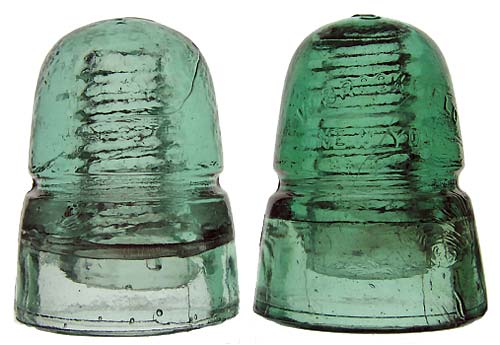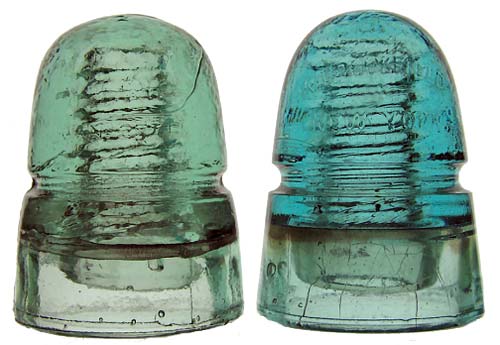[ Home | What's New | Articles ]
The acronym CREB (CRown Embossed Brookfield) was coined by my good friend and fellow CREB CD 145 collector Lee Brewer several years ago to avoid having to type out the long drawn-out description in our email correspondence. Lee and I share an affinity for the CREB CD 145 beehives due to their aesthetic shape and numerous embossing and shop number variations.
Shop numbers are those numbers or letters on the front or rear crown of these pieces that refer to the shop of 4 workers that produced them. In N. R. Woodward’s book “The Glass Insulator in America: 1988 Report”, he explains that the employees at the glassworks were paid based on the number of pieces produced in a given unit of time. This payment method was achieved by counting or weighing the insulators with a given shop number after they emerged from the cooling end of the lehr. This same concept is believed to be the reason for mold letters on the HGCO Petticoat beehives.
CREB 145s can be found with shop numbers 00 through 23 and letters A and B. Within these 26 shop number and letters are over 130 mold variations. These variations include different sizes, backwards numbers, upside down numbers, numbers embossed over other numbers, and numbers embossed above other numbers. Lee and I have used aluminum foil rubbings of these numbers to identify and catalogue these numerous differences.
Not all shop numbers are equally available to collectors. Based on years of experience with collecting these pieces by shop number, the following numbers are difficult to acquire:
5, 12, 15, 16, 17, 19, 12/A
The shop numbers 15, 16, 17, and 19 are typically found either above or below another shop number. These numbers have been found without the accompaniment of other numbers and it is those that I am referring to in the list above. The 12/A listing above refers to a piece that has the shop number 12 on one side of the crown and the shop letter A on the other crown.
This CREB CD 145 Beehive display contains a representative of all shop numbers and letters. Not included are a 15-only or 12/A combination. Only 3 examples of each have been reported. This display does contain a 16-only shop number piece and a 17-only shop number piece. Although very few of these 16-only and 17-only pieces are known to exist in collections, it is premature to call these “rare” as attention to shop numbers is a recent trend in the hobby. Many of these may exist and have simply not been reported.
CREB CD 145 production is believed to have begun in 1884 soon after the Samuel Oakman design patent for the beehive shape (letters patent 99,145 dated January 25, 1870) were the earliest CREB CD 145s produced. Justification for this claim includes the consistently small, weak embossing, low shop numbers, and the absence of the patent date for the beehive shape.
In an interview with William Lord Brookfield he made the statement that the very early crown embossing was small and that the molds were found to deteriorate quite rapidly due to the intense heat of the molten glass. Crown embossing was later increased in size to combat this issue and was eventually removed from Brookfield insulators altogether around 1897 in favor of skirt embossing. The small embossed 1870 patent date CREB CD 145 pieces are therefore assumed to be the initial CREB CD 145 production.
Logic would suggest that the chronology of production of CREB CD 145s could be directly linked to shop number progression; however, several exceptions to this theory exist. For instance, the shop numbers found on the later 83 Fulton CREB CD 145s produced after 1890 are found with shop numbers “00”, “10”, and “11” only. In addition, a shop number “2” can be found on pieces without street address embossing that are believed to have been produced after the 83 Fulton Street molds. The majority of the CREB 145 pieces display the embossing for their 45 Cliff Street address that was their business office from 1881 – 1890. These pieces contain the double patent dates for Oakman’s beehive shape (design patent 14,674 dated February 12, 1884) and for his double petticoat design (letters patent 288,360 dated November 13, 1883).
If you consider Brookfield’s logic for reducing cost by reducing the amount of engraving (Brookfield progressed from “Wm BROOKFIELD” to “W. BROOKFIELD”, to “BROOKFIELD/NEW YORK” to “BROOKFIELD” to “B” through the course of their production history), then the following list is believed to be the chronological list of Brookfield CREB CD 145 styles:
W. BROOKFIELD, 45 CLIFF St., 1870 patent date
W. BROOKFIELD, 45 CLIFF St., no patent dates
W. BROOKFIELD, 45 CLIFF St., double patent dates
W. BROOKFIELD, 83 FULTON St., double patent dates
W. BROOKFIELD, NEW YORK, double patent dates
The McDougald price guide lists the following colors for CD 145 CREBs: blue gray, ice blue, light blue, light blue with milk swirls, blue, aqua, blue aqua, milky aqua, light sapphire blue, light green aqua, green aqua, dark green aqua, light green, apple green, green, light yellow green, yellow green, yellow olive green, lavender/light purple, purple, and dark purple. This CREB CD 145 display contains examples of each of these colors as well as a couple of unlisted colors: teal green, gray green, chartreuse, and cornflower blue. The teal green is comparable to the teal green HGCO/Petticoat beehive. The grey green appears to be from a transition batch of blue gray to light green. Although chartreuse is listed for the skirt embossed Brookfield beehives, CREB examples also exist. Finally, a couple of cornflower blue, or steely blue, examples have been found that are altogether different from the light sapphire blue pieces. The highest value for a CREB CD 145 in the price guide is for the yellow olive green pieces although the blue grey, chartreuse, and cornflower blue 145s are more difficult to acquire.
Of course, as many specialty collectors attest, numerous shades exist within each general color description. This variation is expected due to the knowledge concerning quality control within insulator manufacturing. The use of cullet, or scrap glass, in glass batches can result in numerous variations in color. For example, I have colors that I have ascribed as lime green and vaseline green.
Once I completed a set of all shop numbers and letters, I began the quest to acquire an example of each shop number and letter in some shade of green. Although this goal may not be realistic as no green shop number 5 pieces have been found to date, I am only missing shop numbers 5, 12, and 13 in some variation of green.
Over the course of a decade of collecting CREB CD 145s, several unique discoveries have been made. First is the fact that all ER (Erie Railroad) embossed CREBs (embossing number [060]) are embossed with shop number 22. In addition are the observations that a high percentage of FAB error pieces have shop numbers, that both straight and flare skirt variants exist, and that an unlisted embossing narrow dome version exists.
The 1999 price guide only listed the FAB error (embossing number [070]) pieces without a shop number on the front or rear crown. Most of the FAB error pieces are found with the shop number 1 on the rear crown. As a result, Lee and I were instrumental in the addition of the [087] listing that includes a shop number in the 2003 price guide.
The HGCO Petticoat beehives are known to have straight skirt, or Postal Style, variants. Few collectors, however, are probably aware that these same variations can be found in CD 145 CREBs. The difference is subtle and is most apparent when straighter skirt pieces are placed along side flared skirt specimens. The two styles are depicted in the photo below.

The straight skirts span 3 inches while the flared skirt versions are 3 1/4 inches wide. The vast majority of specimens fall into the straighter skirt category. The flared skirt mold appears to be specific to those pieces bearing an upside down 2 shop number and shop letter B.
Finally, a narrow domed CD 145 CREB style has been found. Again, the difference between this style and the “regular” dome CREBs is slight and only apparent when compared side-by-side. In addition to the narrow, more pointed dome, this variant also has a larger wire groove. Only a few specimens of this style are known to exist in collections. The photo below shows this style on the right adjacent to another CREB CD 145 for comparison.

The embossing for this narrow dome piece is unlisted. The style is similar to the embossing number [150], but the top rear crown patent date is in an arc and not straight across the crown.
Reprinted from Crown Jewels Of the Wide; used with permission
![]() Return to the Research Articles
page
Return to the Research Articles
page
If you have questions or comments, please use this Feedback Form.
Last updated Tuesday, April 10, 2007